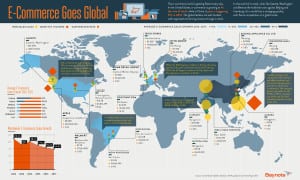 Click the above image to read Baynote’s “World of Ecommerce” infographic, which provides even more data insights on the ecommerce powerhouses both here and abroad.
Click the above image to read Baynote’s “World of Ecommerce” infographic, which provides even more data insights on the ecommerce powerhouses both here and abroad.
Alibaba’s plan to hold its IPO stateside signifies that ecommerce knows no boundaries. Ecommerce is picking up steam around the world with emerging countries seeing the fastest growth in ecommerce activity. India, China and Brazil are in the lead with double-digit expansions year over year.
This rise of global ecommerce has retail leaders staking international claims across nearly every global market. But what factors have facilitated this ecommerce growth worldwide?
When looked at closely, it is clear that most of today’s hot ecommerce markets share common features. Here are the critical factors facilitating ecommerce growth:
- Gross socio-economic factors such as GDP growth and an emerging middle class
- Government policies that support easy access to capital
- Policies and programs that result in a clear path to purchase between retailer and customer
Socio-economic conditions facilitate growth
As more people in a country have more money to spend, discretionary spending increases, which has a multiplier effect: More people buy, more money flows in for investment, which leads more people to buy, which spurs the cycle anew.
Countries experiencing unprecedented economic growth in recent years have seen a big increase in the buying power and participation of the middle class. As a result, ecommerce in developing countries like Brazil, China and India is projected to increase by 19%, 64% and 31% respectively by the end of 2014.
This expansion directly translates into goods and services bought such as smart phones and electronics. Savvy retailers have capitalized on this new wealth by investing in mobile sites and apps that make buying goods online simple and accessible for more people than ever before.
Access to capital
Government fiscal policies determine whether the capital needed for investments in systems and technology is readily available to retailers. Capital markets (like hedge funds and others) support the easy movement of capital.
Sometimes a good business plan needs some outside help to become a reality. Countries with laws that accommodate foreign investment see the fastest growth in e-retail. Here’s a glimpse at a few notable recent investments:
- Ebay doubled down on its investment in India, pouring $134 million into Snapdeal, one of India’s largest online marketplaces.
- Skype co-founder, Niklas Zennstrom, invested $12.3 million in Brazil baby supplies e-retailer, Bebe Store, through his investment firm.
- Alibaba, China’s largest ecommerce provide, announced that it would hold its IPO in the US in a bid to secure even more US investment.
Countries with trade policies that allow for significant cross border commerce tend to see larger growth. Outside funding then follows countries with high growth potential, which translates into investment in companies that also serve their local markets.
Creating a fluid shopping experience
Ecommerce’s success hinges on the development of a seamless customer experience across all channels and devices. No place is this more evident than in mobile where we’re seeing this play out on a massive scale:
- China’s Tencent recently bought a major stake in JD, the second largest ecommerce company behind Alibaba, in order to capitalize its wide mobile user base with ecommerce offerings.
- Germany’s Otto group, one of Europe’s biggest ecommerce players, has recently announced reinvigorated investments in new website software and mobile technology. They plan to sink more than $400 million dollars invested in its mobile payment subsidiary Yapital in an effort to capture the growing mobile market.
In addition to mobile investments, emerging markets are turning to online storefronts as a way for smaller retailers to set up shop on the Internet. Think Amazon Web Services, but customized for different regions of the world. Every country has its own characteristics that retailers need to negotiate in order to meet the needs of their customers.
Impediments to ecommerce growth
Countries’ geopolitical policies have a surprising sway on shopping behavior. Here are some factors that are limiting ecommerce expansion:
Countries are wary of aggressive investing from foreign markets: Like Ebay, Walmart wanted to begin substantial investments in India, but was denied due to the country’s laws that limited the amount a foreign company could invest in certain sectors. Walmart must now build its own presence from scratch.
Countries using currency as a means of jockeying for geopolitical advantages at the expense of customers: In China, more consumers throughout the country are increasingly becoming more open to online payment. However, China’s central bank has moved in to restrict payments, citing a concern for the security of online payments. These moves, under the guise of security, could also signal that China wants to maintain a strong presence within all monetary activity, even at the expense of the economic boon that continued ecommerce expansion would bring.
Countries that have experienced huge growth still must improve major infrastructure: Despite amazing GDP expansion, Brazil still requires costly and wide-scale infrastructure improvements. Though the country has made huge improvements in valuable high-tech industries, there still exists a lack of adequate large scaled infrastructure in support of omnichannel commerce(like widely available electricity, road use and freight and passenger travel) which keeps many investors at bay.
As we watch ecommerce expand globally, we need to ask if all of the right factors are in place for success. The ecommerce wave crashes against every nation’s borders. Countries that wish to take advantage of the rising tide must do everything they can to be ready for the continuing ecommerce evolution.
Marti Tedesco is director of marketing at Baynote.